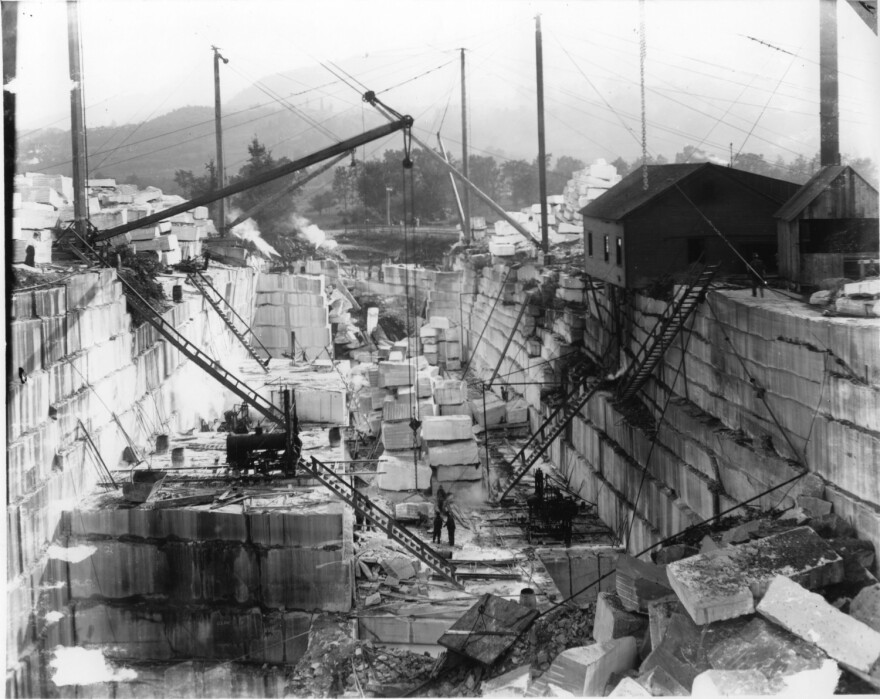Write ups in , and several travel guides have made the Dorset Quarry one of the most popular swimming holes in Vermont. YouTube videos and Facebook posts have meant even more visitors. And while many think the historic quarry is a public park, it’s privately owned by a couple who says it might be time for more help in running the area.
On a recent Wednesday, weather forecasters were calling for temperatures in the 90s and the sunshine was blistering.
Kat Chenail and her friend Celia Bote, of Williamstown, Massachusetts both had the day off from work and wanted to go swimming. Friends had told them about the Dorset Quarry, so they drove up.
“It’s pretty great,� says Chenail. “I’ve been to a lot of swimming holes, and this is one of the only ones where there’s actually places to sit besides in the water.�
As swimming holes go, this one is spacious. It’s about 120 yards long and 30 yards across, with plenty of smooth rock terraces to lounge on and jump off.
“Yeah, we’re trying to get up the courage to jump off this one,� laughs Chenail.
She and Bote peer carefully over the edge of a wall that’s roughly 10 feet above the water.

“Then maybe we’ll get the courage to work our way over to that one,� Chenail says, pointing across the water to a much taller ledge that they say is twice as high. “It’s fun to watch people work up the courage to jump,� says Chenail, laughing.
On the other side of the quarry, a steady stream of thrill seekers jump and somersault off the high ledge. The sound of their splashes echo off the quarry walls.
Meanwhile, crowds of younger kids jump off lower ledges while parents relax nearby.
It took centuries to carve out all the rock walls. Marble from this site was used to build the New York Public Library, The Montreal Museum of Fine Arts and Harvard's medical school to name just a few of the buildings.
But by the start of World War I, many builders were opting for less costly concrete. So this quarry, like many others, shut down.

A spring and nearby stream filled the quarry with water, and by the 1920s it had become a popular swimming hole.
Dorset resident Art Gilbert was a frequent visitor in the 1930s. “On hot days like this we would take off from the house across the valley and we had the quarry pretty much to ourselves," Gilbert recalls. "I remember seeing the farmers come over for a dip after a hot day in the fields haying."
But those sleepy summer days are a thing of the past. Facebook posts, as well as and videos, are bringing larger and larger crowds.
Kirsten and Dick McDonough bought the quarry and the house next door in 1997 and say the increase in usage is stunning.
“Last summer we actually checked the parking lot once a day for six weeks," Kirsten McDonough says. "And in that time period we had 1,400 vehicles from 34 different states � plus three Canadian plates.�

Dick McDonough says when they bought the property it was overgrown and dangerous. �The first time I met the police there, the quarry was not visible from route 30 even though it as only about 15 or 20 feet back,� says McDonough. “So the police officer said to me, ‘We don’t go in there unless there are two of us.� Shaking his head, McDonough recalls, “I thought to myself, 'Oh my God, what have I gotten myself into?'"
But the couple loved the history of the property. So instead of closing it down, they set to work clearing out the trees and brush, opening the quarry up and creating a grassy picnic area and parking lot. They hired excavators who moved stone blocks to create a low wall between the road and the water, and they picked up mountains of trash. All at their own expense.
“Thing is, it’s really a community resource,� says Kirsten McDonough. “And it’s just so beautiful, that it is kind of meant to be shared and people feel like they’re kind of entitled to be there because they’ve been swimming there for so long.�
The couple, who are both attorneys, say Vermont law has also played a crucial role in allowing them to keep the quarry open, by protecting them from liability.
But with more and more visitors, the McDonoughs say the trash, traffic and crowds are getting daunting. The site could use toilets and a changing area, and they say illegal parking is becoming more of a problem.
While no firm plans are in place, they say they’ve begun talks with state and local officials, as well as local volunteer organizations, to see what options there may be to get help running the historic swimming hole, to ensure it stays open for generations to come.








